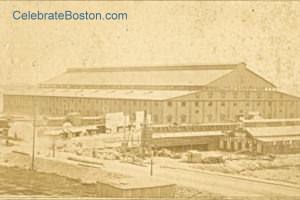Who Are The Hub Men?
Sports, politics and tradition all have equal status in Boston, which has again refused to build a municipal stadium. Is Boston trailing the rest of the country? Maybe it's so far ahead it just seems behind
Boston still celebrates the shot heard round the world with Patriots Day and the Boston Marathon, and it honors as Evacuation Day the date when the British army left town. The Redcoats pulled out sometime after the Battle of Bunker Hill, which was fought some distance away on Breed's Hill, and which, legend and whites of their eyes notwithstanding, the British won in a rout. Then, on Evacuation Day itself, 1,000 Bostonians—a substantial part of the 1776 population—chose, of their own volition, to depart their homes and the Cradle of Liberty and escape with the tyrants. This particular slant on Evacuation Day is not widely promulgated.
But, as Ted Williams would testify, it helps to have a good press in Boston. For instance, it was not Paul Revere who got through to Concord to alert the Minute Men. A British patrol captured Paul Revere. Dr. Samuel Prescott was the rider who warned Concord. Unfortunately, Prescott does not rhyme at all well with "you shall hear," so Revere got the ink. This would be no problem nowadays. Prescott or Revere, the papers would just headline it: HUB MAN WARNS CONCORD. If Neil Armstrong had come from Dorchester or Charlestown, it would have been: HUB MAN ON MOON. If a Pope ever comes out of Southie (South Boston), it will be: TAB HUB MAN PONTIFF
Boston is ambivalent, ironic, at odds with itself. "The place was still a cow pasture till John L. Sullivan put it on the map," says Sam Silverman, the fight promoter, offering yet another theory of Boston history. The Hub Men lionized that barroom bully, but they busted Mencken for peddling his American Mercury on the Common. Banned in Boston is still not passé. They arrested anyone who showed I Am Curious (Yellow), and the whole state supreme court went off to examine Hair. One of the most prominent black athletes in Boston recently bought a house in a white neighborhood. The man who sold him the house was immediately thrashed by a next-door neighbor. Bill Russell dismisses Boston as the hole in a sugared liberal doughnut. Yet nowhere is there a more liberal thrust. Boston is capital of the first state that passed a law challenging the President's authority to order soldiers to Vietnam.
Boston is the town that sold Babe Ruth to New York, saluted the cab driver that ran down Casey Stengel and greeted its own Celtics, the greatest basketball team ever, with ennui. It took 50 years for major league baseball to move a team, and as soon as it made up its mind it hustled a club out of Boston over a weekend. The Hub Men yawned when the Redskins went to Washington and stirred even less when the football Yanks left. Fewer than 5% of the Patriot stockholders even bother to buy season tickets. Boston locked Cassius Clay and Sonny Liston out of town long before Clay's draft troubles. Rocky Marciano came from just down the road at Brockton, but he could never get into Boston because there was always a guy with a warrant out to grab him and hang some obscure suit on him. "I've been scuffling for 40 years—since I was 16," says Bill Veeck, now the head of Suffolk Downs. "Before I got to Boston I was sued just once—and it was thrown right out of court. I've been here only 18 months and have been involved in eight suits." They threw fines and everything else at Ted Williams. Who are these Hub Men?
Now I have lived here all my life and I never knew Boston had the first major indoor arena that could hold 50,000 that was built in 1869!!!!!
Walking down the street one day in 1867, a Hub Man by the name of Patrick S. Gilmore saw a vision of "a vast structure" in his home town. Gilmore turned the dream into reality and had a gigantic Temple of Peace constructed in only three months in 1869 at a cost of $120,750.68. The monster temple measured 500 feet by 300 feet, with the ceiling 100 feet high. It had a capacity of 50,000, and as such was the last structure erected in Boston that would satisfy the seating requirements of the National Football League. Sadly for Billy Sullivan, the Temple of Peace was blown down in a storm.
The arena was located where Trinity Church and the Copley Plaza now stand. It was HUGE.

The building was 550 feet long by 350 feet wide, covering about 4-1/2 acres. The main walls were 40 feet high, resting upon a substantial foundation of piles, and the height of the central point of the roof was 120 feet.
The parquet was 235 feet long by 200 in width, surrounded upon three sides by promenades 25 feet wide under the galleries. These galleries were 75 feet deep, being 10 feet from the parquet in front and rising backwards to the wall. Entrance was had by 12 doorways, each 25 feet wide, and access to the galleries was via 12 broad stairways leading directly from the outside doors.
The Organ was built by J.H. Wilcox & Co. and was purportedly the most powerful instrument ever constructed until then. It was without a case and fills a space 30 feet wide by 20 feet deep. It contains 1786 pipes, the larges being 43 feet high. It was supplied by wind from 8 pumps worked by a gas engine. The Chorus numbered about 20,000, from all parts of the Union.
I highly recommend this article from 40 years ago.
No comments:
Post a Comment